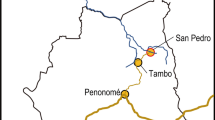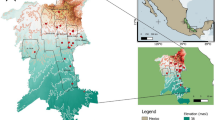Abstract
A challenge in establishing agroforestry systems is ensuring that farmers are interested in the tree species, and are aware of how to adequately manage these species. This challenge was tackled in the Atlantic Rainforest biome (Brazil), where a participatory trial with agroforestry coffee systems was carried out, followed by a participatory systematisation of the farmers experiences. Our objective was to identify the main tree species used by farmers as well as their criteria for selecting or rejecting tree species. Furthermore, we aimed to present a specific inventory of trees of the Leguminosae family. In order to collect the data, we reviewed the bibliography of the participatory trial, visited and interviewed the farmers and organised workshops with them. The main farmers’ criteria for selecting tree species were compatibility with coffee, amount of biomass, production and the labour needed for tree management. The farmers listed 85 tree species; we recorded 28 tree species of the Leguminosae family. Most trees were either native to the biome or exotic fruit trees. In order to design and manage complex agroforestry systems, family farmers need sufficient knowledge and autonomy, which can be reinforced when a participatory methodology is used for developing on-farm agroforestry systems. In the case presented, the farmers learned how to manage, reclaim and conserve their land. The diversification of production, especially with fruit, contributes to food security and to a low cost/benefit ratio of agroforestry systems. The investigated agroforestry systems showed potential to restore the degraded landscape of the Atlantic Rainforest biome.


Similar content being viewed by others
References
Altieri M, Nicholls CI (2000) Agroecologia: Teoría y práctica para una agricultura sustentable. Red de Formación Ambiental para América Latina y el Caribe, Programa de las Naciones Unidas para el Medio Ambiente, México DF
Barberi A, Carneiro MAC, Moreira FMS, Siqueira JO (1998) Nodulação em Leguminosas Florestais em Viveiros no Sul de Minas Gerais. Cerne 4:145–153
BRASIL (1965) Código Florestal Brasileiro, Lei No. 4771, DOU 15 de setembro de 1965. Brasília
Bridson D, Forman L (1999) The herbarium handbook. Royal Botanic Gardens, Kew, Richmond
Cardoso IM, Guijt I, Franco FS, Carvalho AF, Ferreira-Neto PS (2001) Continual learning for agroforestry system design: university, NGO and farmer partnership in Minas Gerais, Brazil. Agrofor Syst 60:235–257
Carvalho AF, Ferreira-Neto PS (2000) Evolving leaning in designing agroecological farming systems with small-scale farmers in Zona da Mata, Brazil. In: Guijt I, Berdegué JA, Loevinsohn M, Hall F (eds) Deepening the basis of rural resource management. ISNAR, The Hague, pp 73–88
Cuenca G, Aranguren J, Herrera R (1983) Root growth and litter decomposition in a coffee plantation under shade trees. Plant Soil 71:477–486
Dean W (1995) With broadax and firebrand: the destruction of the Brazilian Atlantic Forest. University of California Press, Berkeley
Diez-Hurtado A (2001) Guía Metodologico para la Sistematizacion de Experiencias del Secretariado Rural. Secretariado Rural do Peru, Lima
Douthwaite B, Kuby T, van de Fliert E, Schulz S (2003) Impact pathway evaluation: an approach for achieving and attributing impact in complex systems. Agric Syst 78:243–265
Drummond GM, Martins CS, Machado ABM, Sebaio FA, Yasmine A (2005) Biodiversidade em Minas Gerais: um atlas para sua conservação, 2nd edn. Fundação Biodiversitas, Belo Horizonte
Duarte EMG (2007) Ciclagem de nutrientes por árvores em sistemas agroflorestais na Mata Atlântica. MSc Thesis, Federal University of Viçosa, Viçosa
Faria SM, Franco AA, Jesus RM, Menandro MS, Baitello JB, Mucci ES, Döbereiner J, Sprent JI (1984) New nodulating legume trees from South-East Brazil. New Phytol 98:317–328
Fernandes JM (2007) Taxonomia e etnobotânica de Leguminosae Adans. em fragmentos florestais e sistemas agroflorestais na Zona da Mata Mineira. MSc Thesis, Federal University of Viçosa, Viçosa
Ferrari EA (1996) Desenvolvimento da Agricultura Familiar: a experiência do CTA-ZM. In: Alvares VH, Fontes LEF, Fontes MPF (eds) O Solo nos Grandes Domínios Morfoclimáticos do Brasil e o Desenvolvimento Sustentado. Sociedade Brasileira de Ciência do Solo, Viçosa, pp 233–250
Franco FS (1995) Diagnóstico e desenho de Sistemas Agroflorestais em microbacias hidrográficas no município de Araponga, Zona da Mata de Minas Gerais. MSc Thesis, Federal University of Viçosa, Viçosa
Franco FS (2000) Sistemas Agroflorestais: uma contribuição para a conservação dos recursos naturais da zona da Mata de Minas Gerais. Ds. Thesis, Federal University of Viçosa, Viçosa
Franco AA, Faria SM (1997) The contribution of N2-fixing tree legumes to land reclamation and sustainability in the tropics. Soil Biol Biochem 29:897–903
Freitas HR, Cardoso IM, Jucksch I (2004) Legislação ambiental e uso da terra: o caso da Zona da Mata de Minas Gerais. Boletim Informativo, Rev Bras Ci Solo 29:22–27
Golfari L (1975) Zoneamento ecológico do Estado de Minas Gerais para reflorestamento. Série Técnica, 3. CPFRC, Belo Horizonte
Guijt I (1999) Monitoramento Participativo: conceitos e ferramentas práticas para a agricultura sustentável. 1a. Ed. ASPTA, Rio de Janeiro
Harvey CA, Komar O, Chazdon R, Ferguson BG, Finegan B, Griffith DM, Martínez-Ramos M, Morales H, Nigh R, Soto-Pinto L, van Breugel M, Wishnie M (2008) Integrating agricultural landscapes with biodiversity conservation in the Mesoamerican hotspot. Conserv Biol 22:8–15
Horn PM, Stür HH (2003) Developing agricultural solutions with smallholders—how to get start with participatory approach. ACIAR monograph no. 99. CIAT, Vientianane. (http://www.ciat.cgiar.org/asia/pdf/aciar_monograph99_contents.pdf). Accessed 12 Jun 2008
IBGE (2005) Lavoura permanente. (http://www.ibge.gov.br/cidadesat/default.php). Accessed 28 Jan 2009
Jaramillo-Botero C (2007) Resposta de cafeeiros ao sombreamento e à dinâmica de serrapilheira em condições de sistema agroflorestal. Ds. Thesis, Federal University of Viçosa, Viçosa
Jose S (2009) Agroforestry for ecosystem services and environmental benefits: an overview. Agrofor Syst 76:1–10
Lewis GP, Owen PE (1989) Legumes of the Ilha de Maracá. Royal Botanic Gardens, Kew, Richmond
Lewis G, Schrine B, Mackinder B, Lock M (2005) Legumes of the world. Royal Botanic Gardens, Kew, Richmond
McGinty MM, Swisher ME, Alavalapati J (2008) Agroforestry adoption and maintenance: self-efficacy, attitudes and socio-economic factors. Agrofor Syst 73:99–108
Mekoya A, Oosting SJ, Fernandez-Rivera S, Van der Zijpp AJ (2008) Farmers’ perceptions about exotic multipurpose fodder trees and constraints to their adoption. Agrofor Syst 73:141–153
Méndez EV, Gliessman SR, Gilbert GS (2007) Tree biodiversity in farmer cooperatives of a shade coffee landscape in western El Salvador. Agric Ecosyst Environ 119:145–159
Mercer DE (2004) Adoption of agroforestry innovations in the tropics: a review. Agrofor Syst 61:311–328
Ministério do Meio Ambiente (2006) Resolução do Conama, edição 61. http://www.mma.gov.br/port/conama/res/res06/res36906.xml. Accessed 17 Jan 2009
Morais H, Marur CJ, Caramori PH, Ribeiro ANA, Gomes JC (2003) Características fisiológicas e de crescimento do cafeeiro sombreado com guandu e cultivado a pleno sol. Pesq Agrop Bras 38:1131–1137
Myers N, Mittermeier RA, Mittermeier CG, da Fonseca GAB, Kent J (2000) Biodiversity hotspots for conservation priorities. Nature 403:853–858
Oliveira RD, Oliveira MD (1982) Pesquisa social educativa: conhecer a realidade para poder transformá-la. In: Brandão CR (ed) Pesquisa participante, 2nd edn. Ed. Brasiliense, São Paulo, pp 17–33
Ribeiro CAN (2003) Florística e fitossiologia de um trecho de Floresta Atlântica de Altitude na Fazenda da Neblina, Parque Estadual da Serra do Brigadeiro. MSc Thesis, Federal University of Viçosa, Viçosa
Rice R (2008) Agricultural intensification within agroforestry: the case of coffee and wood products. Agric Ecosyst Environ 128:212–218
Salgado BG, Macedo RLG, Alvarenga MIN, Venturin N (2006) Avaliação da fertilidade dos solos de sistemas agroflorestais com cafeeiro (Coffea arabica L.) em Lavras-MG. Árvore 30:343–349
Santos SRM, Miranda IS, Tourinho MM (2004) Análise florística e estrutural de sistemas agroflorestais das várzeas do rio Juba, Cametá, Pará. Acta Amazonica 34:251–263
Saporetti-Júnior AW (2005) Composição florística e estrutura do componente árboreo em um remanescente de Floresta Atlântica Montana, Araponga, MG. MSc Thesis, Federal University of Viçosa, Viçosa
Scherr SJ (1991) On-farm research: the challenges of agroforestry. Agrofor Syst 15:95–110
Siqueira LC (2008) Levantamento florístico e etnobotânico do estrato arbóreo em Sistemas Naturais e Agroflorestais, Araponga, Minas Gerais. MSc Thesis, Federal University of Viçosa, Viçosa
Soares MP, Saporetti-Júnior AW, Meira-Neto JAA, da Silva FA, de Souza AL (2006) Composição florística do estrato árboreo de floresta atlântica interiorana em Araponga, Minas Gerais. Árvore 30:859–870
Soto-Pinto L, Villalvazo-López V, Jimenez-Ferrer G, Ramirez-Marcial N, Montoya G, Sinclair FL (2007) The role of local knowledge in determining shade composition of multistrata coffee systems in Chiapas, Mexico. Biodivers Conserv 16:419–436
Souza HN (2006) Sistematização da experiência participativa com sistemas agroflorestais: rumo à sustentabilidade da agricultura familiar na Zona da Mata Mineira. MSc Thesis, Federal University of Viçosa, Viçosa
Sprent JI (2001) Nodulation in legumes. Royal Botanic Gardens, Kew, Richmond
Valverde O (1958) Estudo Regional da Zona da Mata de Minas Gerais. Rev Bras Geografia 20:3–82
Vandermeer J, Perfecto I (2007) The agricultural matrix and a future paradigm for conservation. Conserv Biol 21:274–277
Veloso HP (1991) Manual técnico da vegetação brasileira. Departamento de Recursos Naturais e Estudos Ambientais, Fundação Instituto Brasileiro de Geografia e Estatística, Rio de Janeiro
Vivan JL (2000) Saber ecológico e sistemas agroflorestais: um estudo de caso na Floresta Atlântica do Litoral Norte do RS, Brasil. MSc Thesis, Federal University of Santa Catarina, Florianópolis
Acknowledgments
The authors thank the farmers and their organisations for sharing this experience, the Brazilian sponsors FAPEMIG (Fundação para o Amparo da Pesquisa do Estado de Minas Gerais), for financial support, CAPES (Coordenação de Pessoal de Ensino Superior) for a scholarship to the first and third author, Arne Janssen, Mirjam Pulleman and Lijbert Brussaard for useful comments and corrections on an earlier version of this paper, and two anonymous reviewers for constructive comments.
Author information
Authors and Affiliations
Corresponding author
Rights and permissions
About this article
Cite this article
Souza, H.N., Cardoso, I.M., Fernandes, J.M. et al. Selection of native trees for intercropping with coffee in the Atlantic Rainforest biome. Agroforest Syst 80, 1–16 (2010). https://doi.org/10.1007/s10457-010-9340-9
Received:
Accepted:
Published:
Issue Date:
DOI: https://doi.org/10.1007/s10457-010-9340-9




